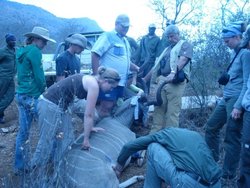Abstract: Granulomatous colitis in French Bulldogs
 Tuesday, July 3, 2012 at 06:00AM
Tuesday, July 3, 2012 at 06:00AM Winner, Cases and Abstracts category
Alison Manchester, Cornell University
GRANULOMATOUS COLITIS IN FRENCH BULLDOGS IS ASSOCIATED WITH INVASIVE E. COLI AND CLINICAL RESPONSE TO FLUOROQUINOLONE ANTIBIOTICS.
A Manchester1, S Hill2, B Sabatino3, R Armentano4, B Kessler1, M Miller1, B Dogan1, SP McDonough1, KW Simpson1. 1. College of Veterinary Medicine, Cornell University, Ithaca, NY. 2. Veterinary Specialty Hospital, San Diego, CA. 3. College of Veterinary Medicine, University of Tennessee, Knoxville, TN. 4. College of Veterinary Medicine, University of Florida, Gainesville, FL.
French bulldogs have been reported to develop a form of inflammatory bowel disease that is histopathologically similar to granulomatous colitis of Boxer dogs (GCB). GCB is associated with mucosally invasive E. coli, whose eradication correlates with clinical remission. We sought to determine the clinical features, presence or absence of intramucosal bacteria and E. coli in colonic biopsies, and response to fluoroquinolone antibiotics in French bulldogs with GC. 
 FISH staining to identify multifocal accumulations of intramucosal E. coli in colonic biopsies
FISH staining to identify multifocal accumulations of intramucosal E. coli in colonic biopsies
Five French bulldogs (4M, 1F; median age 10mo, range 5-12mo) with a histological diagnosis of GC were studied. Bacterial colonization was evaluated using eubacterial (EUB-338) and E. coli-specific FISH probes. E. coli were isolated and antimicrobial resistance was determined by broth microdilution MIC from available fresh biopsies. Response to fluoroquinolone antibiotics was determined by monitoring clinical signs.
 Cornell,
Cornell,  abstract,
abstract,  colitis,
colitis,  french bulldogs,
french bulldogs,  granulomatous colitis in
granulomatous colitis in  Cases/Abstracts
Cases/Abstracts 

